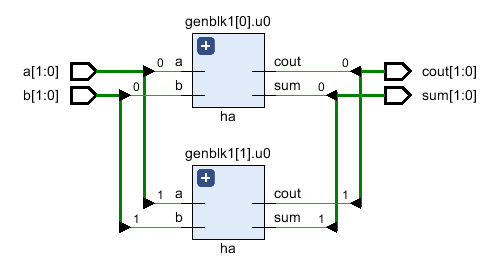Verilog 生成块
generate 块允许乘以模块实例或执行任何模块的条件实例化。它提供了基于 Verilog 参数构建设计的能力。当需要多次重复相同的操作或模块实例,或者必须根据给定的 Verilog 参数有条件地包含某些代码时,这些语句特别方便。
generate 块不能包含端口、参数、specparam 声明或 specify 块。但是,允许使用其他模块项和其他生成块。所有生成实例都在 module 中编码 以及关键字 generate 之间 和 endgenerate .
生成的实例可以有模块、连续赋值、always 或 initial 块和用户定义的原语。有两种类型的生成构造 - 循环和条件。
- 生成for循环
- 否则生成
- 生成案例
生成循环
半加器将在另一个名为 my_design 的顶层设计模块中使用 generate 实例化 N 次 for 循环构造。循环变量必须使用关键字 genvar 声明 它告诉工具该变量将在生成块的详细说明期间专门使用。
// Design for a half-adder
module ha ( input a, b,
output sum, cout);
assign sum = a ^ b;
assign cout = a & b;
endmodule
// A top level design that contains N instances of half adder
module my_design
#(parameter N=4)
( input [N-1:0] a, b,
output [N-1:0] sum, cout);
// Declare a temporary loop variable to be used during
// generation and won't be available during simulation
genvar i;
// Generate for loop to instantiate N times
generate
for (i = 0; i < N; i = i + 1) begin
ha u0 (a[i], b[i], sum[i], cout[i]);
end
endgenerate
endmodule
测试台
testbench 参数用于控制设计中半加器实例的数量。当 N 为 2 时,my_design 将有两个半加器实例。
module tb;
parameter N = 2;
reg [N-1:0] a, b;
wire [N-1:0] sum, cout;
// Instantiate top level design with N=2 so that it will have 2
// separate instances of half adders and both are given two separate
// inputs
my_design #(.N(N)) md( .a(a), .b(b), .sum(sum), .cout(cout));
initial begin
a <= 0;
b <= 0;
$monitor ("a=0x%0h b=0x%0h sum=0x%0h cout=0x%0h", a, b, sum, cout);
#10 a <= 'h2;
b <= 'h3;
#20 b <= 'h4;
#10 a <= 'h5;
end
endmodule
a[0] 和 b[0] 给出输出 sum[0] 和 cout[0] 而 a[1] 和 b[1] 给出输出 sum[1] 和 cout[1]。
模拟日志ncsim> run a=0x0 b=0x0 sum=0x0 cout=0x0 a=0x2 b=0x3 sum=0x1 cout=0x2 a=0x2 b=0x0 sum=0x2 cout=0x0 a=0x1 b=0x0 sum=0x1 cout=0x0 ncsim: *W,RNQUIE: Simulation is complete. ncsim> exit
看到详细的 RTL 确实有两个由 generate 生成的半加法器实例 块。

生成如果
下面显示的是使用 if else 的示例 在 generate 内 构造以在两个不同的多路复用器实现之间进行选择。第一个设计使用 assign 实现多路复用器的语句,而第二个设计使用 case 陈述。在顶层设计模块中定义了一个名为 USE_CASE 的参数,用于在两个选项之间进行选择。
// Design #1: Multiplexer design uses an "assign" statement to assign
// out signal
module mux_assign ( input a, b, sel,
output out);
assign out = sel ? a : b;
// The initial display statement is used so that
// we know which design got instantiated from simulation
// logs
initial
$display ("mux_assign is instantiated");
endmodule
// Design #2: Multiplexer design uses a "case" statement to drive
// out signal
module mux_case (input a, b, sel,
output reg out);
always @ (a or b or sel) begin
case (sel)
0 : out = a;
1 : out = b;
endcase
end
// The initial display statement is used so that
// we know which design got instantiated from simulation
// logs
initial
$display ("mux_case is instantiated");
endmodule
// Top Level Design: Use a parameter to choose either one
module my_design ( input a, b, sel,
output out);
parameter USE_CASE = 0;
// Use a "generate" block to instantiate either mux_case
// or mux_assign using an if else construct with generate
generate
if (USE_CASE)
mux_case mc (.a(a), .b(b), .sel(sel), .out(out));
else
mux_assign ma (.a(a), .b(b), .sel(sel), .out(out));
endgenerate
endmodule
测试台
Testbench 实例化顶层模块 my_design 并将参数 USE_CASE 设置为 1,以便它使用 case 实例化设计 声明。
module tb;
// Declare testbench variables
reg a, b, sel;
wire out;
integer i;
// Instantiate top level design and set USE_CASE parameter to 1 so that
// the design using case statement is instantiated
my_design #(.USE_CASE(1)) u0 ( .a(a), .b(b), .sel(sel), .out(out));
initial begin
// Initialize testbench variables
a <= 0;
b <= 0;
sel <= 0;
// Assign random values to DUT inputs with some delay
for (i = 0; i < 5; i = i + 1) begin
#10 a <= $random;
b <= $random;
sel <= $random;
$display ("i=%0d a=0x%0h b=0x%0h sel=0x%0h out=0x%0h", i, a, b, sel, out);
end
end
endmodule
当参数USE_CASE为1时,从仿真日志可以看出多路复用器设计使用case 语句被实例化。而当USE_CASE为零时,复用器设计使用assign 语句被实例化。这可以从模拟日志中打印的显示语句中看到。
// When USE_CASE = 1 ncsim> run mux_case is instantiated i=0 a=0x0 b=0x0 sel=0x0 out=0x0 i=1 a=0x0 b=0x1 sel=0x1 out=0x1 i=2 a=0x1 b=0x1 sel=0x1 out=0x1 i=3 a=0x1 b=0x0 sel=0x1 out=0x0 i=4 a=0x1 b=0x0 sel=0x1 out=0x0 ncsim: *W,RNQUIE: Simulation is complete. // When USE_CASE = 0 ncsim> run mux_assign is instantiated i=0 a=0x0 b=0x0 sel=0x0 out=0x0 i=1 a=0x0 b=0x1 sel=0x1 out=0x0 i=2 a=0x1 b=0x1 sel=0x1 out=0x1 i=3 a=0x1 b=0x0 sel=0x1 out=0x1 i=4 a=0x1 b=0x0 sel=0x1 out=0x1 ncsim: *W,RNQUIE: Simulation is complete.
生成案例
生成案例允许基于 case 在另一个模块中实例化模块、初始块和始终块 表达式来选择众多选项之一。
// Design #1: Half adder
module ha (input a, b,
output reg sum, cout);
always @ (a or b)
{cout, sum} = a + b;
initial
$display ("Half adder instantiation");
endmodule
// Design #2: Full adder
module fa (input a, b, cin,
output reg sum, cout);
always @ (a or b or cin)
{cout, sum} = a + b + cin;
initial
$display ("Full adder instantiation");
endmodule
// Top level design: Choose between half adder and full adder
module my_adder (input a, b, cin,
output sum, cout);
parameter ADDER_TYPE = 1;
generate
case(ADDER_TYPE)
0 : ha u0 (.a(a), .b(b), .sum(sum), .cout(cout));
1 : fa u1 (.a(a), .b(b), .cin(cin), .sum(sum), .cout(cout));
endcase
endgenerate
endmodule
测试台
module tb;
reg a, b, cin;
wire sum, cout;
my_adder #(.ADDER_TYPE(0)) u0 (.a(a), .b(b), .cin(cin), .sum(sum), .cout(cout));
initial begin
a <= 0;
b <= 0;
cin <= 0;
$monitor("a=0x%0h b=0x%0h cin=0x%0h cout=0%0h sum=0x%0h",
a, b, cin, cout, sum);
for (int i = 0; i < 5; i = i + 1) begin
#10 a <= $random;
b <= $random;
cin <= $random;
end
end
endmodule
请注意,因为实例化了半加器,所以 cin 对输出 sum 和 cout 没有任何影响。
模拟日志ncsim> run Half adder instantiation a=0x0 b=0x0 cin=0x0 cout=00 sum=0x0 a=0x0 b=0x1 cin=0x1 cout=00 sum=0x1 a=0x1 b=0x1 cin=0x1 cout=01 sum=0x0 a=0x1 b=0x0 cin=0x1 cout=00 sum=0x1 ncsim: *W,RNQUIE: Simulation is complete.
Verilog


